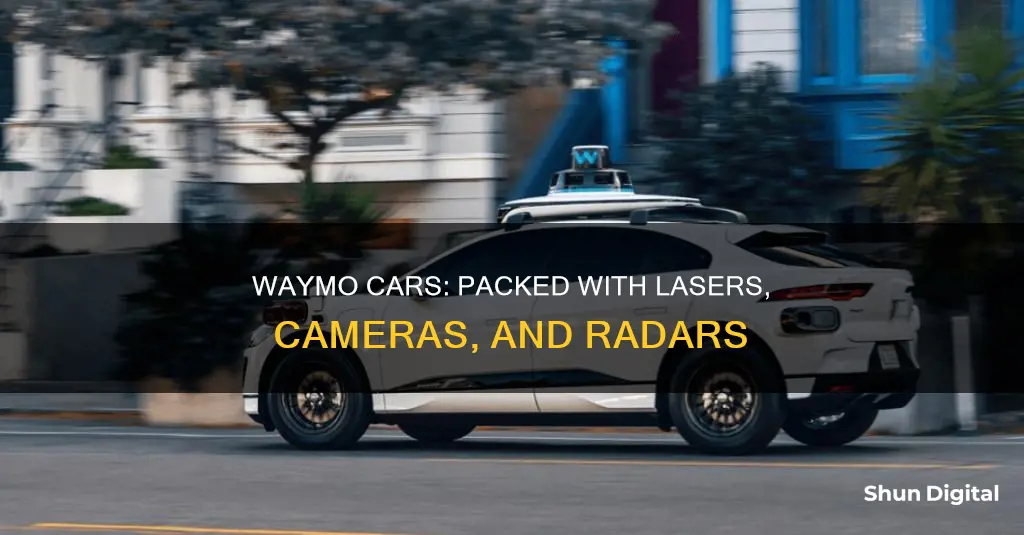
Waymo's self-driving cars are equipped with a range of sensors, including cameras, radar, and Light Detection and Ranging (LiDAR) technology, to enable 360-degree perception of their surroundings. These sensors work in conjunction with advanced artificial intelligence (AI) software, allowing the vehicles to navigate complex environments safely. While the exact number of each type of sensor may vary, Waymo's Jaguar I-Pace model, for example, features 29 cameras, advanced radar capabilities, and multiple LiDAR sensors. These sensors provide overlapping fields of view, high-resolution imaging, and the ability to detect objects at varying distances, contributing to the overall safety and efficiency of the self-driving system.
| Characteristics | Values |
|---|---|
| Number of Lasers/LIDAR | 4 |
| Number of Cameras | 29 |
| Number of Radars | 6 |
What You'll Learn
- Waymo's 5th-generation self-driving system has 29 cameras, providing a 360-degree view
- The lidar sensors create a 3D picture of the Waymo car's surroundings
- Radar technology helps Waymo cars see in tough weather conditions like rain, fog, and snow
- Waymo's Jaguar I-Pace RoboTaxi has 4 spinning lidar units, 6 radar units, and 14 cameras
- Waymo cars use AI to calculate a safe route and respond to the evolving traffic environment

Waymo's 5th-generation self-driving system has 29 cameras, providing a 360-degree view
Waymo's 5th-generation self-driving system has 29 cameras, providing a simultaneous 360-degree view around the vehicle. The cameras are designed with high dynamic range and thermal stability, allowing them to capture more detail and provide sharper images in various lighting conditions, from daylight to low-light environments. This enables the system to identify important details such as pedestrians and traffic lights, even from hundreds of meters away.
The high-dynamic range and thermal stability of the cameras enable them to tackle more complex environments and enhance the overall safety of the vehicle. With this advanced camera system, the Waymo Driver can navigate challenging situations and make informed decisions with a comprehensive understanding of its surroundings.
The placement of the cameras on the Waymo vehicle is carefully designed to provide overlapping fields of view. This arrangement ensures that the system can capture a full 360-degree perspective, enhancing its ability to detect and identify objects in the vicinity.
The camera system works in conjunction with other sensors, such as lidar and radar, to provide a multi-layered approach to sensing and understanding the environment. While lidar creates a 3D picture of the surroundings, and radar tracks the velocity of objects, the cameras add visual data to the mix, enabling the system to identify and interpret complex scenes.
The combination of these advanced sensors and the powerful artificial intelligence (AI) software enables the Waymo Driver to navigate complex driving situations and make real-time decisions to ensure a safe and efficient journey. The integration of these cutting-edge technologies showcases Waymo's commitment to innovation and safety in the field of autonomous driving.
GoPro Cameras: Which Models Offer the Longest Battery Life?
You may want to see also

The lidar sensors create a 3D picture of the Waymo car's surroundings
Waymo's self-driving cars use a combination of Light Detection and Ranging (LiDAR), cameras, and radar to navigate the roads. These sensors work together to provide a comprehensive view of the vehicle's surroundings, with LiDAR playing a crucial role in creating a 3D picture of the car's environment.
LiDAR, or Light Detection and Ranging, is a key component of the Waymo Driver's sensor suite. It uses lasers to create a detailed 3D map of the car's surroundings. The LiDAR sensors are placed all around the vehicle, emitting millions of laser pulses in all directions. These lasers bounce off objects, and by measuring the time it takes for the lasers to return, the system can accurately determine the size and distance of objects. This technology works day and night and even in challenging weather conditions.
Waymo's fifth-generation LiDAR system offers higher resolution and a range of over 300 meters. It provides a bird's-eye view of the surroundings, helping the car distinguish objects such as opening car doors or road debris on highways. Additionally, perimeter LiDARs placed at four points around the vehicle's sides enhance spatial resolution and accuracy, enabling the car to navigate tight gaps in city traffic and hilly terrain.
The LiDAR data is combined with information from cameras and radar to create a detailed understanding of the car's environment. Cameras provide a 360-degree field of view, capturing high-resolution images in various lighting conditions. They can spot objects such as traffic lights, construction zones, and pedestrians from hundreds of meters away. Meanwhile, radar complements the system by measuring an object's speed and direction, even in rain, fog, or snow.
Waymo's advanced sensor suite, including LiDAR, cameras, and radar, enables the self-driving cars to make sense of their surroundings and navigate complex environments safely. The 3D picture created by LiDAR is a crucial component of this technology, allowing the cars to understand and interact with the world around them.
Focus Faster: Quick Camera Tricks for Sharp Photos
You may want to see also

Radar technology helps Waymo cars see in tough weather conditions like rain, fog, and snow
Waymo's self-driving cars are equipped with a range of sensors, including cameras, radar, and LiDAR technology, that work together to enable the vehicles to navigate safely through complex environments. One of the key advantages of radar technology is its ability to enhance the car's performance in challenging weather conditions, such as rain, fog, and snow.
Radar technology plays a crucial role in helping Waymo's self-driving cars navigate through adverse weather. While LiDAR and cameras provide valuable data for object detection and mapping, radar brings unique capabilities to the table. Radar can detect and measure the velocity of objects, which is essential for understanding the vehicle's surroundings and making real-time driving decisions. This capability is especially useful in low-visibility conditions caused by rain, fog, or snow, where other sensors may struggle.
Waymo's fifth-generation self-driving system incorporates advanced radar technology, which the company claims is the “most advanced” in any automotive system available today. They have redesigned the architecture, outputs, and signal processing capabilities of their radar system, creating one of the world's first imaging radar systems specifically tailored for self-driving cars. This imaging radar provides higher resolution, enhanced range, and a wider field of view compared to traditional automotive radar.
The imaging radar system in Waymo's cars can detect objects at great distances, including motorcyclists hundreds of meters away. This extended range gives the vehicle's onboard computer more time to process information and make driving decisions, resulting in a smoother and more comfortable experience for riders. The radar system also complements the LiDAR and camera sensors by providing additional data points to improve the accuracy of object detection and mapping.
Waymo's extensive testing in various weather conditions has validated the performance of their radar technology. Their fifth-generation hardware sensor suite has undergone rigorous testing, including exposure to stormy weather, salted roads, extreme heat, and dirt storms. This comprehensive testing ensures that the radar system can withstand the challenges posed by tough weather conditions and consistently provide accurate data to the self-driving system.
In summary, Waymo's integration of advanced radar technology into its self-driving cars is a crucial factor in ensuring safe and reliable operation, even in challenging weather conditions. By providing valuable data on object velocity and enhanced performance in rain, fog, and snow, radar plays a key role in Waymo's overall sensor suite, working in conjunction with LiDAR and cameras to enable the vehicles to navigate complex and unpredictable environments safely.
Understanding P Mode: A Photographer's Creative Companion
You may want to see also

Waymo's Jaguar I-Pace RoboTaxi has 4 spinning lidar units, 6 radar units, and 14 cameras
The Waymos Jaguar I-Pace RoboTaxi is equipped with an array of sensors that enable it to navigate and understand its surroundings. At the core of this sensor suite are four spinning lidar units, six radar units, and fourteen cameras, all working together to provide a comprehensive 360-degree view of the vehicle's environment.
The four spinning lidar units are positioned strategically around the vehicle, with one at the front, two on the sides, and one at the rear. This setup provides full 360-degree coverage, allowing the lidar system to paint a 3D picture of the surroundings. Lidar, or Light Detection and Ranging, sends out millions of laser pulses in all directions and measures the time it takes for them to bounce back, providing accurate distance information. With a range of over 300 meters, Waymo's lidar system enables the vehicle to identify objects, even in challenging conditions like driving into the sun or on moonless nights.
Complementing the lidar system are the six radar units, which are designed to work in tandem with the lidars and cameras. Radar has the unique ability to see and measure an object's speed and direction, providing crucial data for the vehicle's understanding of its environment. Waymo claims that its radars are the most advanced in any automotive system, with higher resolution, range, and field of view than previous iterations. This enhanced radar system enables the vehicle to accurately detect objects, including motorcyclists, at great distances, providing valuable reaction time for a smoother ride.
The fourteen cameras in the Waymos Jaguar I-Pace RoboTaxi are strategically placed to provide overlapping fields of view, ensuring a comprehensive visual perspective. These cameras are designed with high dynamic range and thermal stability, enabling them to capture sharper images, even in low-light conditions. The camera system allows the vehicle to identify important details, such as pedestrians and traffic signs, from over 500 meters away. Additionally, the cameras work in conjunction with the lidar system, providing additional context to the traffic scene and enhancing the overall perception capabilities of the autonomous vehicle.
The combination of these sensors—lidar, radar, and cameras—working in unison with advanced artificial intelligence (AI) software, enables the Waymos Jaguar I-Pace RoboTaxi to safely navigate complex driving environments. This multi-modal approach ensures redundancy and enhances the vehicle's ability to understand and interact with its surroundings, making it a reliable and safe option for passengers.
Understanding Tapo Camera's Home and Away Modes
You may want to see also

Waymo cars use AI to calculate a safe route and respond to the evolving traffic environment
Waymo cars use a combination of advanced sensors and AI to calculate a safe route and respond to the evolving traffic environment. The sensors include cameras, radar, and Light Detection and Ranging (LiDAR) technology. The 5th-generation Waymo Driver has 29 cameras that provide a 360-degree view, allowing it to identify pedestrians and stop signs from over 500 meters away. The high-dynamic range and thermal stability of the cameras enable them to capture sharper images, even in challenging lighting conditions.
The Waymo cars also use radar technology, which has been improved to offer higher resolution, range, and field of view. Radar is crucial for detecting objects in adverse weather conditions, such as rain, fog, and snow. It provides the Waymo Driver with an object's distance and speed, enhancing safety.
Additionally, the LiDAR sensors play a vital role in mapping the surroundings. These sensors emit millions of laser pulses in all directions and measure the time it takes for them to bounce back, creating a 3D picture of the vehicle's surroundings. This technology gives the Waymo Driver a bird's-eye view of its environment, helping it understand the size and distance of objects within a 300-meter range.
The data gathered from these sensors is then processed by Waymo's advanced AI system, which uses machine learning to make sense of the complex information. It can identify objects such as pedestrians, cyclists, vehicles, and road signs, and predict their possible paths. By combining the sensor data with highly detailed maps, the Waymo Driver can instantly plan the safest route, determining the trajectory, speed, lane changes, and steering maneuvers necessary for a safe journey.
The AI system also enables the car to respond in real time to the dynamic traffic environment, continuously improving its performance with each trip. Waymo's extensive testing and simulation programs further enhance the system's ability to handle various scenarios and ensure the safety of its passengers and other road users.
Miami Camera Tickets: Your Options and Rights Explained
You may want to see also
Frequently asked questions
Waymo cars use LIDAR technology, which emits millions of laser pulses in all directions. There are four perimeter LIDARs placed at four points around the sides of the vehicle, and one 360-degree LIDAR on the roof.
Waymo's Jaguar I-PACE model has 29 cameras integrated around the body of the vehicle, providing overlapping fields of view. This includes cameras on the front bumper, front fenders, rearview mirrors, and roof.
Waymo's Jaguar I-PACE model has six radar units, two on the front, two on the sides, and two on the rear, providing 360-degree coverage.







